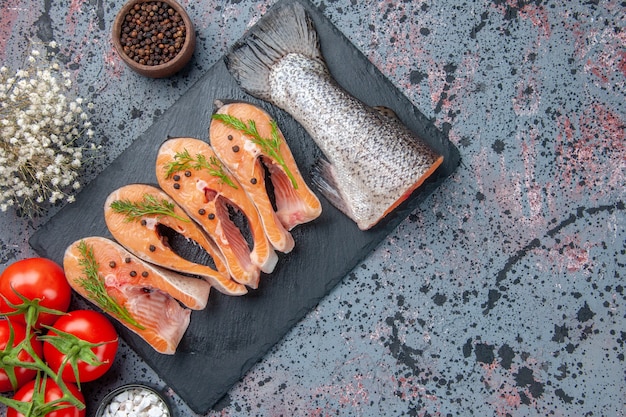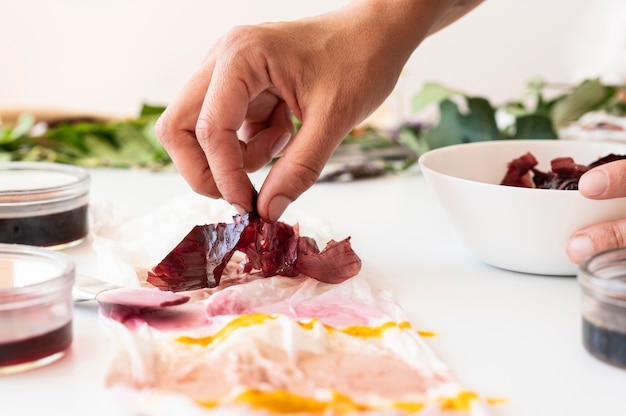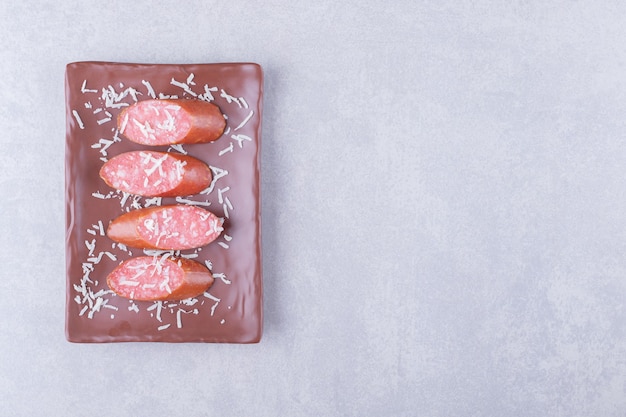Let's face it, we've all been there. You're craving bacon, but you realize you've forgotten to take it out of the freezer. Panic sets in! "frozen bacon? That's impossible!" you might think. But hold on, my fellow bacon enthusiasts. It's not as daunting as it seems. With a few simple tricks and techniques, you can cook frozen bacon that's just as crispy, juicy, and delicious as fresh bacon.
I've been a bacon aficionado for years, and I've learned a thing or two about cooking frozen bacon. So, grab your favourite frying pan and join me on this journey to bacon heaven, even if it's a little frozen.
Part 1: Why Cook Frozen Bacon?

Beyond the Fridge: A Case for Frozen Bacon
Now, you might be wondering, "Why bother with frozen bacon?" Well, let's be honest, it's not ideal. But sometimes, life throws us curveballs. We've all had those mornings when we're rushing around and simply don't have time to thaw the bacon. Frozen bacon is a lifesaver in those moments. Grab a few slices and get cooking!
And let's not forget about food waste. We've all been there - buying a whole pack of bacon only to find we can't use it all before it goes bad. Freezing the rest is a fantastic way to avoid waste and have a backup stash for those spontaneous bacon cravings.
Another surprising fact: frozen bacon can sometimes have a more concentrated and intense flavour than fresh bacon. This is because the freezing process can concentrate the flavour compounds, resulting in a more robust, almost richer bacon experience.
The Challenges of Frozen Bacon
It's not all sunshine and rainbows, though. Cooking frozen bacon does come with a few challenges. First, it takes a little longer to cook, so you'll need a bit more patience. Second, if you're not careful, it can turn out tough or chewy. But fear not, my friend! That's where this guide comes in. We're going to break down everything you need to know to cook frozen bacon perfectly.
Part 2: Preparing Frozen Bacon

Thawing Techniques: From Fridge to Counter
Before you start cooking, you need to thaw your bacon. There are a few methods you can use:
Refrigerator Thawing: This is the most reliable and recommended method. Place your bacon in the fridge for a few hours or overnight. This allows the bacon to thaw slowly and evenly, preserving its texture and flavour.
Countertop Thawing: This is a faster option if you're short on time, but it's not ideal. Make sure your kitchen is cool, and be sure to keep a close eye on the bacon. The goal is to thaw it thoroughly, but not let it sit out at room temperature for too long.
Cold Water Thawing: This method is quick but requires some attention. Submerge your bacon in a bowl of cold water, making sure it's fully submerged. Change the water every 30 minutes or so to keep it cold. This method should thaw your bacon in about 30 minutes.
Choosing Your Cooking Method: From Stovetop to Oven
Once your bacon is thawed, it's time to choose your cooking method. Each method has its own advantages, so consider what works best for you and your kitchen setup.
Pan-Frying: This is my go-to method for cooking bacon, frozen or fresh. It's quick, easy, and produces deliciously crispy bacon. Simply heat a pan over medium heat, add your bacon, and cook until golden brown and crispy, flipping halfway through.
Oven-Baking: This is ideal for larger batches of bacon, as it cooks evenly without constant attention. Preheat your oven to 375 degrees Fahrenheit (190 degrees Celsius). Line a baking sheet with parchment paper, arrange the bacon in a single layer, and bake for 15-20 minutes, or until crispy.
Air-Frying: Air fryers are amazing for cooking bacon! They produce wonderfully crispy bacon in a fraction of the time with minimal mess. Preheat your air fryer to 400 degrees Fahrenheit (200 degrees Celsius), arrange the bacon in a single layer, and cook for 5-7 minutes, or until golden brown and crispy.
Part 3: The Art of pan-frying frozen bacon

The Ultimate Crispy Bacon Experience
Let's dive into the art of pan-frying frozen bacon. It's a classic technique, and it's all about achieving that perfect crisp and that satisfying sizzle. Grab your favourite non-stick pan, and let's get started!
Preparing the Pan:
Heat it Up: Place your pan over medium heat. You want to render the bacon fat slowly, not burn it. To test the heat, sprinkle a few drops of water on the pan. If it sizzles and evaporates quickly, you're good to go.
Laying Out the Bacon:
Space It Out: Don't overcrowd the pan. If you pile the bacon in too close, it will steam instead of crisping up. Make sure each slice has plenty of room to breathe. This is crucial for achieving even cooking and maximum crispness.
Patience is Key:
Let it Cook: Once you've laid out your bacon, resist the urge to flip it right away! Let it cook undisturbed for a few minutes. You'll see the fat starting to render and the bacon beginning to curl and crisp up.
Flipping and Finishing:
Flip with Care: After a few minutes, use tongs to carefully flip the bacon slices. Continue cooking for another few minutes, or until the bacon reaches your desired level of crispness. The edges should be golden brown and the fat mostly rendered.
Draining for Perfection:
Remove Excess Fat: Once the bacon is cooked, drain it on a paper towel-lined plate or wire rack. This removes excess fat and helps the bacon stay nice and crispy.
Part 4: Masterclass in Oven-Baking Frozen Bacon
Batch Cooking: The oven method
Oven-baking is perfect for cooking larger batches of bacon, and it's a great option if you want to set it and forget it.
Preheat and Prep:
Oven Time: Preheat your oven to 375 degrees Fahrenheit (190 degrees Celsius). Make sure the oven is fully preheated before adding the bacon for consistent and even cooking.
Line it Up: Line a baking sheet with parchment paper to prevent sticking and make cleanup a breeze.
Arranging the Bacon:
Even Distribution: Place your bacon strips on the baking sheet in a single layer, making sure they're not overlapping. This allows for even cooking and air circulation. If you have a large amount of bacon, you may need to use multiple baking sheets.
Bake to Perfection:
cooking time: Bake the bacon for 15-20 minutes, depending on the thickness of your slices. Start checking the bacon after about 15 minutes. You'll know it's done when it's golden brown, crispy, and the fat has mostly rendered.
Cooling and Storing:
Cooling Time: Once the bacon is cooked, remove it from the oven and place it on a wire rack to cool. This helps it stay crispy and prevents it from getting soggy.
Storage: Store cooked bacon in an airtight container in the refrigerator for up to a week. You can also freeze leftover bacon for up to 3 months. Place it in a freezer-safe bag, squeeze out as much air as possible, and seal it tightly.
Part 5: The Air Fryer Approach to Frozen Bacon
Crispy Bacon in Minutes
Air fryers are a game-changer for bacon lovers. They create crispy, delicious bacon in a short amount of time, with minimal mess.
Preheating Your Air Fryer:
Start Hot: Preheat your air fryer to 400 degrees Fahrenheit (200 degrees Celsius). Refer to your air fryer manual for specific preheating times.
Arranging Your Bacon:
One Layer Only: Arrange your frozen bacon slices in the air fryer basket, making sure they're not overlapping. If your air fryer basket is large enough, you may be able to fit multiple pieces of bacon, but avoid overcrowding.
Cooking Time:
Bacon Clock: Cook the bacon for 5-7 minutes, or until it's golden brown and crispy. Start checking it after about 5 minutes, as cooking times can vary slightly based on the thickness of your bacon and your air fryer model.
Signs of Doneness:
Golden and Crispy: Your bacon is ready when it's golden brown and crispy, with most of the fat rendered out. If you're unsure, carefully remove a slice and check its crispness.
Part 6: Tips and Tricks for Perfect Frozen Bacon
Mastering the Details for Exceptional Bacon
Here are a few extra tips and tricks to ensure your frozen bacon turns out perfect every time:
Temperature Control: Temperature is key! Whether you're pan-frying, oven-baking, or air-frying, make sure your cooking temperature is consistent. Too high a temperature can burn the bacon, while too low a temperature can result in soggy bacon.
Avoid Overcrowding: Overcrowding the pan, baking sheet, or air fryer basket will create steam and prevent the bacon from crisping up evenly. Give those slices plenty of space.
Flip for Even Crispness: When pan-frying, flip the bacon halfway through cooking to ensure that both sides are cooked evenly and achieve maximum crispness.
Drain for Maximum Crispness: After cooking, drain the bacon on a paper towel-lined plate or wire rack to remove excess fat and maintain its crispy texture.
Part 7: Serving and Storing Frozen Bacon
Enjoying Your Crispy Creation
Your bacon is cooked to perfection! Now, it's time to enjoy it! Serve it hot and crispy, just as it comes out of the pan, oven, or air fryer.
Here are some delicious ways to enjoy your bacon:
Breakfast Bliss: Add it to a breakfast sandwich or a plate of eggs for a classic and satisfying start to the day.
Salads and Soups: Chop it up and add it to salads for a salty, crunchy element or sprinkle it on soups for a touch of flavour.
Pasta Perfection: Crumble bacon and add it to pasta dishes for a savoury, smoky flavour.
Pizza Topping: Use crumbled bacon as a topping for your pizzas.
Sweet and Savoury Snack: Wrap bacon around dates or figs for a unique sweet and savoury snack.
Storing Leftovers:
Refrigerator Storage: Store leftover bacon in an airtight container in the refrigerator for up to a week.
Freezing for Later: Freeze cooked bacon for up to 3 months. Place it in a freezer-safe bag, squeeze out as much air as possible, and seal it tightly.
Part 8: The Science Behind Cooking Frozen Bacon
Understanding the Physics and Chemistry
Let's dive into the science behind why cooking frozen bacon can be a little trickier than cooking fresh bacon.
The Physics of Freezing:
Ice Crystal Disruption: When you freeze bacon, the water inside the muscle cells turns into ice crystals. These ice crystals disrupt the structure of the muscle fibres, making the bacon less tender and more prone to drying out. This is why frozen bacon often needs to be cooked more slowly to allow the ice crystals to melt gradually.
The Chemistry of Fat Rendering:
Fat Rendering and Ice Crystals: Fat rendering is the process of melting the fat inside the muscle cells, which gives bacon its crispy texture. However, the presence of ice crystals in frozen bacon can slow down the fat rendering process, which is why it can take longer for frozen bacon to become crispy.
Part 9: FAQs
Here are some common questions about cooking frozen bacon:
Q1: Can I cook frozen bacon directly from the freezer?
No, it's not recommended to cook bacon directly from the freezer. It will take much longer to cook and is more likely to become unevenly cooked and tough.
Q2: How do I know if my frozen bacon is cooked through?
When cooked properly, frozen bacon should be golden brown and crispy, with the fat rendered out. The internal temperature should reach at least 155 degrees Fahrenheit (68 degrees Celsius) for safe consumption.
Q3: Can I freeze cooked frozen bacon?
Yes, you can freeze cooked frozen bacon. Place it in a freezer-safe bag, squeeze out the air, and seal it tightly. It should last for up to 3 months in the freezer.
Q4: Is frozen bacon as healthy as fresh bacon?
Frozen bacon and fresh bacon are generally considered to have the same nutritional content. However, remember to cook frozen bacon properly to avoid dryness and toughness.
Q5: What should I do if my frozen bacon turns out tough?
If your frozen bacon turns out tough, try cooking it for a shorter time next time. You can also try adding a small amount of water to the pan while cooking to help prevent it from drying out.
There you have it! You're now equipped with the ultimate guide to cooking frozen bacon perfectly. With a little patience and these tips, you can turn even the most frozen slab of bacon into a crispy, delicious treat. Happy cooking!
Everyone is watching

How to Cook Frozen Lobster Tails Perfectly: A Step-by-Step Guide
RecipesLobster. Just the word conjures up images of lavish meals, special occasions, and a taste of luxury. But let's...

Pork Fillet Cooking Time: How Long to Cook It Perfectly
RecipesPork fillet, or tenderloin as it's sometimes called, is a real favourite in our house. It's so versatile, and...

Pigs in a Blanket Cooking Time: How Long to Bake for Perfect Results
RecipesAh, pigs in a blanket. Just the name conjures up images of those delightful little parcels of crispy pastry en...

The Ultimate Guide to Cooking Delicious Frankfurters
RecipesLet's face it, we all love a good frankfurter. It's a classic, simple, and always satisfying. But let's be rea...

Wolf Meat Recipes: A Guide to Cooking Wild Game
RecipesLet's be honest, you don't see wolf meat at your local butcher shop every day. It's a bit of a wild card, but ...
